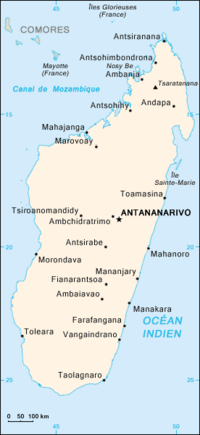Antananarivo
2008/9 Schools Wikipedia Selection. Related subjects: African Geography
| Antananarivo Tananarive |
|||
| Antananarivo at sunset, March 2005 | |||
|
|||
| Nickname: Tana | |||
| Location of Antananarivo in Madagascar | |||
| Country | Madagascar | ||
|---|---|---|---|
| Founded | 1625 | ||
| Elevation | 1,276 m (4,186 ft) | ||
| Population (2001 census) | |||
| - Total | 1,403,449 | ||
| Time zone | East African Time (GMT+3) ( UTC) | ||
Antananarivo (pronounced /ˌtəˌnænəˈriːv/ or /ˌtəˌnɑːnəˈriːv/) is the capital and largest city in Madagascar. It is also known by its French name Tananarive or the colonial shorthand form Tana.
The larger urban area surrounding the city, known as Antananarivo-Renivohitra ("Antananarivo-Capital"), is the capital of the Analamanga region and of the Antananarivo autonomous province.
Location
Antananarivo is situated in the centre of the island length-wise, and 145 km (90 miles) away from the eastern coast. The city occupies a commanding position, being built on the summit and slopes of a long and narrow rocky ridge, which extends north and south for about 4 km (2 mi) and rising at its highest point to about 200 m (660 ft) above the extensive rice plain to the west, although the town is at about 1,275 m (4,183 ft) above sea level. It is Madagascar's largest city and is its administrative, communications, and economic centre. The city is located 215 km (134 mi) west-southwest of Toamasina, the principal seaport of the island, with which it is connected by railway, and for about 100 km (62 mi) along the coastal lagoons, a service of small steamers.
History
Unlike most capital cities in southern Africa, Antananarivo was already a major city before the colonial era. The city was founded circa 1625 by King Andrianjaka and takes its name (the City of the Thousand) from the number of soldiers assigned to guarding it. For many years it was the principal village of the Hova chiefs and gained importance as those chiefs made themselves sovereigns of the greater part of Madagascar, eventually becoming a town of some 80,000 inhabitants. In 1793 it was made the capital of the Merina kings. The conquests of King Radama I made Antananarivo the capital of almost all of Madagascar. Until 1869 all buildings within the city proper were of wood or rushes, but even then it possessed several timber palaces of considerable size, the largest being 120 ft (37 m) high. These crown the summit of the central portion of the ridge; and the largest palace, with its lofty roof and towers, is the most conspicuous object from every point of view.
Since the introduction of stone and brick, the entire city has been rebuilt and now contains numerous European-style structures, including the royal palaces, the houses formerly belonging to the prime minister and nobles, the French residency, the Anglican and Roman Catholic cathedrals, and several stone churches.
Present day
The city was captured by the French in 1895 and incorporated into their Madagascar protectorate. After the French conquest of Madagascar when the city had a population of some 100,000, it was extensively remodeled as the population grew to 175,000 by 1950. Roads were constructed throughout the city, broad flights of steps connecting places too steep for the formation of carriage roads, and the central space, called Andohalo, was enhanced with walks, terraces, flower-beds and trees. Water, previously obtained from springs at the foot of the hill, was brought from the Ikopa River, which skirts the capital to the south and west.
After independence in 1960 the pace of growth increased rapidly. The city's population reached 1.4 million by the end of the twentieth century. Industries include food products, cigarettes, and textiles.
The city is guarded by two forts built on hills to the east and south-west. Including an Anglican and a Roman Catholic cathedral, there are about fifty churches in the city and its suburbs, as well as a Muslim mosque. Antananarivo hosts a campus of the University of Madagascar and the Collège Rural d'Ambatobe.






